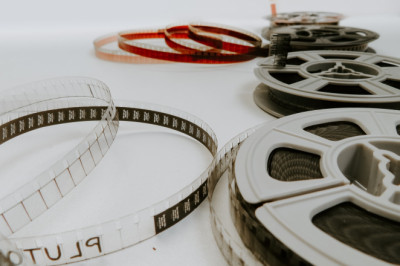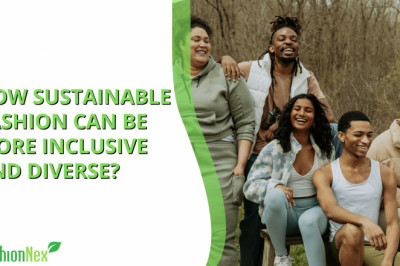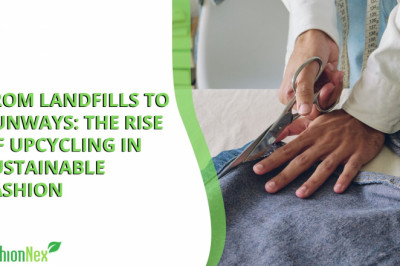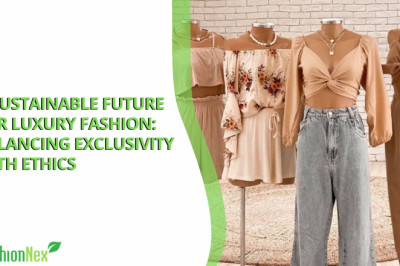views

Fast fashion refers to the quick manufacturing of inexpensive clothing that is intended to swiftly transition from the runway to stores. Offering consumers fashionable clothing at a fraction of the price of conventional fashion, has completely changed the fashion industry.
Fast fashion's detrimental effects on the earth and society, however, cannot be disregarded. Fast fashion is produced and discarded in ways that substantially harm the environment, deplete natural resources, and exploit laborers in developing nations.
On the other hand, slow fashion is a different perspective on fashion that encourages ethical and sustainable practices in the creation and consumption of apparel. The fundamentals of slow fashion, why it is superior to fast fashion, and practical applications of slow fashion will all be covered in this article.
Slow Fashion
Slow fashion is a way of doing fashion that prioritizes quality over quantity, ethical manufacturing, and sustainability. It aims to develop a more responsible and thoughtful approach to clothing production and consumption in reaction to the detrimental effects of fast fashion on the environment and society.
The principles of slow fashion include designing and producing clothing with a focus on durability, using sustainable and environmentally-friendly materials, supporting fair labor practices, and reducing waste. Slow fashion also places importance on transparency and traceability in the supply chain, allowing consumers to make informed choices about the clothing they purchase.
In essence, slow fashion is a holistic approach to fashion that encourages a shift towards a more sustainable and responsible fashion industry. It values the social and environmental impact of fashion production and consumption and seeks to create a system that is beneficial to all stakeholders involved in the process.
Advantages of Slow Fashion
1. Better quality products
Slow fashion places a strong emphasis on the creation of high-quality apparel that is intended to last longer than rapid fashion items, which is one of its main benefits.
Slow fashion companies hire skilled artisans to meticulously craft clothes that are designed to be worn for years. These clothes are made from durable and sustainable materials like organic cotton or recycled fabrics.
As a result, waste is reduced and a product of higher quality that is less likely to rapidly disintegrate or go out of style is produced.
2. Reduced environmental impact
Slow fashion's lessening effect on the environment is one of its main benefits. Slow fashion has the potential to considerably lessen the detrimental effects of the fashion industry on the environment by emphasizing the use of sustainable materials, cutting waste, and promoting local production.
To reduce the amount of clothing that ends up in landfills, slow fashion also pushes consumers to purchase fewer items and make more thoughtful decisions.
3. Support of local and ethical production
Slow fashion encourages regional and ethical manufacturing, which guarantees that clothes are made by people who are treated fairly and given a living wage. By generating employment chances and decreasing reliance on outsourcing to low-wage nations, this strategy supports local economies and communities.
Additionally, it guarantees safe and healthy working circumstances for employees, which is not always the case in the manufacturing of fast fashion. Slow fashion encourages ethical and local manufacturing while advancing responsible and sustainable fashion practices.
4. Preservation of traditional crafts and techniques
Slow fashion promotes the preservation of traditional crafts and techniques, which are often at risk of being lost in the fast-paced and mass-produced world of fashion. By supporting local artisans and manufacturers who use traditional methods to produce clothing, slow fashion helps to sustain these important cultural practices and heritage.
This also creates a unique value proposition for consumers who appreciate the handcrafted quality and uniqueness of such clothing.
5. Emphasis on individual style and self-expression
Slow fashion promotes personal style and self-expression by emphasizing one-of-a-kind, high-quality items over mass-produced, generic apparel. Slow fashion encourages purchasing items that represent one's style and can be worn for many years by valuing the design and craftsmanship of clothing.
With a focus on individuality, fashion culture can be more varied and inventive and move beyond the homogeneity of fast fashion styles.
Implementing Slow Fashion
-
Building a sustainable wardrobe
Adopting slow fashion requires you to create a sustainable style. It entails making long-term investments in high-quality apparel that is both stylish and functional and can be worn for many years. This entails prioritizing ethical production methods and selecting products made from sustainable materials like organic cotton or recycled fabrics.
In addition, it entails avoiding fast fashion trends that encourage disposable clothing and caring for clothing correctly to increase its lifespan. Individuals can lessen their environmental impact and aid in the development of a more ethical fashion business by creating a sustainable wardrobe.
-
Thrift shopping and vintage clothing
Vintage clothing and thrift store buying are excellent slow fashion strategies. By buying used clothing, we can extend the life of garments that would otherwise wind up in landfills and lower the demand for new clothing production.
A fun and inexpensive way to play with personal style while promoting sustainable fashion practices is through thrift shopping and vintage apparel.
-
DIY and upcycling
Slow fashion is frequently used in DIY and upcycling projects. Individuals can make distinctive pieces and increase the usefulness of their clothing by reusing or altering it. Waste is reduced and the need for fresh clothing production is decreased.
Upcycling can involve embellishing, adjusting the size, or transforming garments into new products like bags or accessories. Additionally, DIY and upcycling give people the chance to show their individuality and creativity.
-
Supporting ethical and sustainable brands
Making deliberate and knowledgeable clothing buy decisions is a part of implementing slow fashion. We can make sure that the clothing we purchase is produced ethically and sustainably by supporting companies that uphold these values.
This entails selecting clothing that is of high quality and is built to last, as well as backing companies that put a high priority on using equitable labor practices, eco-friendly materials, and sustainable production techniques.
Related- From vegan leather to recycled polyester: Innovations in sustainable fashion materials
Fashionnex Final Words
Finally, there is no doubt that the fast fashion business has a detrimental effect on both the environment and society. Natural resources are being depleted, there is pollution, and trash because of the overproduction and disposal of cheap, low-quality clothing.
Furthermore, workers and communities, especially in developing nations, suffer from the industry's pervasive exploitative labor practices. Through the adoption of slow fashion, we can have a positive effect by promoting more ethical and sustainable production practices, assisting ethical and sustainable businesses, and reducing waste through thoughtful consumption.
We can practice slow fashion in several ways, including choosing high-quality and long-lasting clothing, mending and upcycling clothing, and limiting our consumption. The environment and society as a whole can ultimately benefit from our individual decisions when we work together to build a more equitable and sustainable fashion industry.











Comments
0 comment